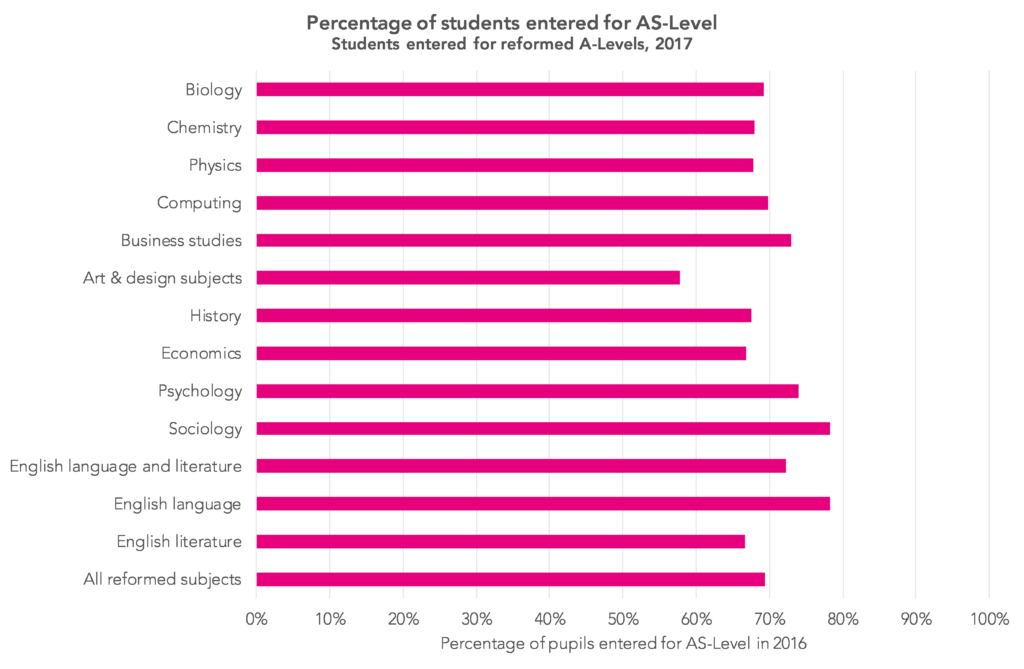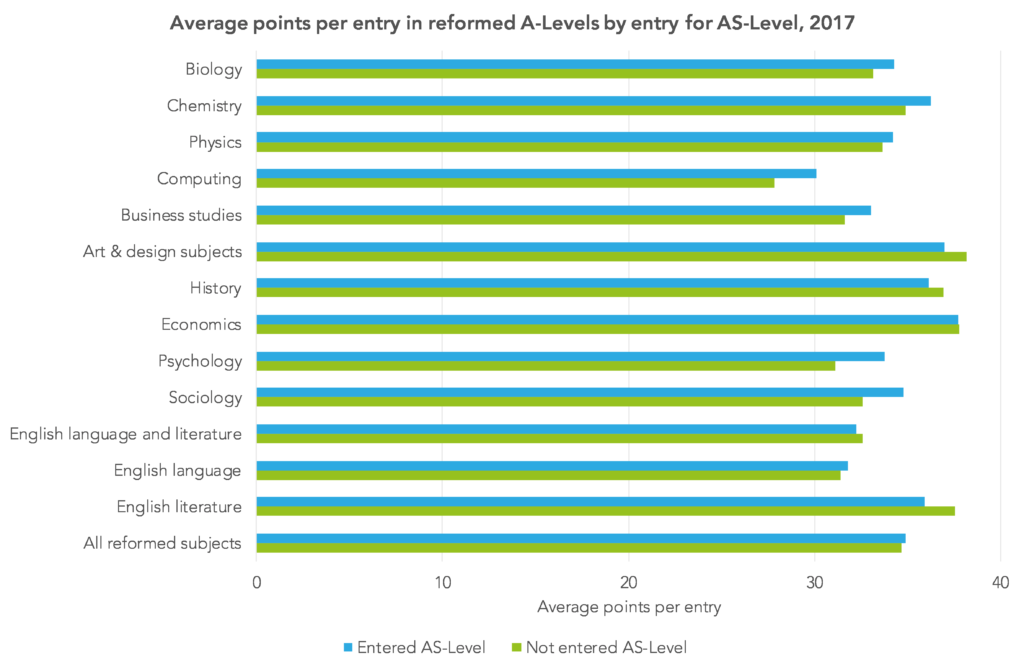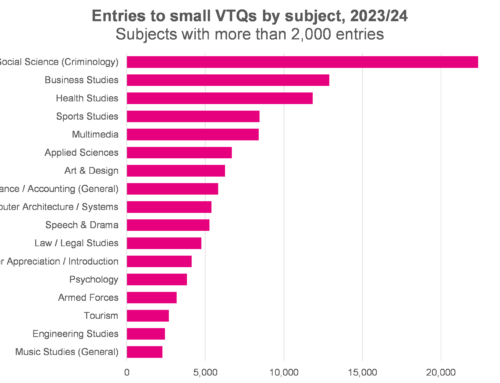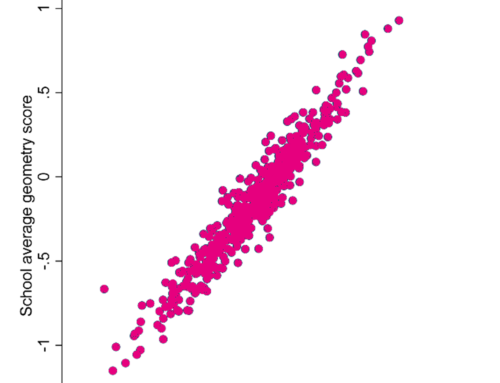This blogpost forms part of a package of A-Level and GCSE results analysis, with funding received from the Nuffield Foundation. View our results day microsite, which shows national trends in entries and attainment for each A-Level and AS-Level subject. Data for 2018 will be available from 9.30am on 16 August.
Tomorrow we’ll see the first set of A-Level results in the second wave of subjects to have been reformed in England, which includes geography, modern foreign languages, dance, drama, music, PE and religious studies.
These will follow reformed A-Levels in art and design subjects, business studies, economics, history, psychology, sociology and sciences, results for which came out for the first time last year.
Reformed AS-Levels and A-Levels have been decoupled, which means that results in AS-Levels do not contribute to A-Level grades. Entries in AS-Levels have plummeted as a result.
But several readers have been in touch to ask whether entering an AS-Level still has any impact on subsequent A-Level grades.
I’ll be honest at the outset. We can’t answer the question definitively with the data at hand. But we can skirt around it.
Linking results in AS-Levels and A-Levels
Using 2017 data from the National Pupil Database, we can compare the A-Level results in reformed subjects of students who were entered for AS-Levels in 2016 to those of students who were not entered for AS-Levels.
Almost 70% of entries in reformed A-Levels can be linked to a corresponding AS-Level entry in the same subject from the previous summer. The match rate will be a lot lower in the 2018 data.
However, there are variations between subjects. Under 60% of A-Level entries in art and design subjects can be linked, whereas the equivalent figures are nearer to 80% in English language and sociology.
Students in independent schools were much less likely to have been entered for an AS-Level (44%) compared to counterparts in the FE sector (78%) and the state-funded mainstream school sector (70%). We wondered at the time whether smaller institutions would be less likely to spend money on AS-Levels.
Generally, students entered for AS-Levels in 2016 tended to achieve slightly higher A-Level results in 2017, although this wasn’t consistent across the subjects.
In art and design subjects, history and English literature, those entered for an AS-Level went on to achieve slightly lower A-Level results.
The differences are small, however. The largest difference (psychology) is 2.7 points, equivalent to just over a quarter of a grade.
Of course, we cannot assume from this that entry for AS-Level explains the differences between the two groups. For starters, we’d need to account for why some students were entered whilst others were not.
Were the former group more motivated? Were they more likely to attend particular types of schools or colleges? Did they have a greater need for grades to support their UCAS applications?
We need to create some sort of comparison that can rule out some of these competing explanations.
Comparing to maths
Large numbers of students who were entered for A-Levels in biology, chemistry and physics in 2017 were also entered for A-Level maths, which had not yet been decoupled from AS-Level.
This means we can compare A-Level results in maths with those in reformed subjects for the same set of students.
Average points score (APS) per entry are shown in the table below. Students have been divided into two groups – those who were entered for AS-Level in the reformed subject and those who were not. (APS is a measure which turns A-Level grades into points: from 10 for an E, up in intervals of 10 to 60 for an A*.)
How to read the table
To explain the numbers in the table, let’s take biology as an example.There were 22,045 students entered for both biology and mathematics, of which 14,940 entered AS-Level biology in 2016 and 7,105 did not.
The group which took AS-Level biology achieved a slightly higher average points score per entry in A-Level biology (40.4) than the group which did not (39.4), a difference of 1.0.
However, there was much less of a difference in their A-Level maths results. The group which entered AS-Level biology achieved an APS per entry of 39.4 compared to 39.6, a difference of -0.2.
The difference in the two differences is 1-(-0.2) = 1.2, and this figure is presented in the final column as a crude indicator of the effect of entering AS-Level biology on A-Level biology outcomes.
On the whole, students entered for AS-Levels in the four subjects shown in the table above tended to achieve slightly higher A-Level results, with the difference being equivalent to around a tenth of an A-Level grade. For those of you who like to work in effect sizes, it’s about 0.07 of a standard deviation, a little more in biology and chemistry and a bit less in physics.
Summing up
None of this is definitive but it suggests that students who were entered for AS-Levels in the first wave of reformed subjects subsequently achieved slightly higher A-Level results than those who did not. Perhaps entering the AS-level was useful practice for some.
There are some important caveats, of course.
Firstly, we haven’t considered drop-out after AS-Level. Were those who took AS-Level biology, for example, more likely to drop out before completing the full course? This could have the effect of flattering the results for those who took both the AS-Level and the A-Level.
Secondly, the analysis is based on students with A-Level entries in 2017 matched to AS-Level entries in 2016. AS-Level entries fell further in 2017 and so it will be worthwhile repeating it using 2018 A-Level data (when it becomes available) to see whether the effect is still present.
This blogpost forms part of a package of A-Level and GCSE results analysis, with funding received from the Nuffield Foundation. View our results day microsite, which shows national trends in entries and attainment for each A-Level and AS-Level subject. Data for 2018 will be available from 9.30am on 16 August.












Leave A Comment